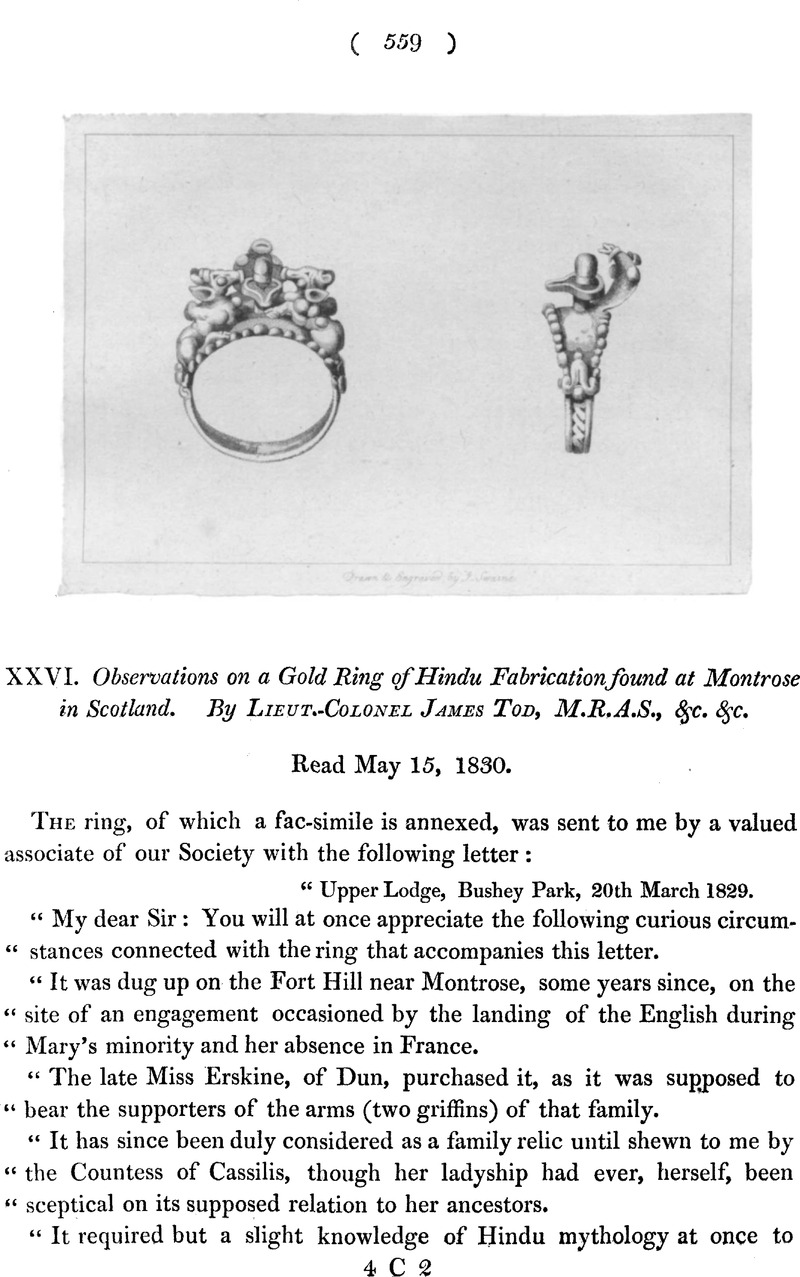No CrossRef data available.
Article contents
XXVI. Observations on a Gold Ring of Hindu Fabrication found at Montrose in Scotland
Published online by Cambridge University Press: 24 September 2009
Abstract

- Type
- Letter
- Information
- Transactions of the Royal Asiatic Society of Great Britain and Ireland , Volume 2 , Issue 2 , July 1830 , pp. 559 - 571
- Copyright
- Copyright © The Royal Asiatic Society 1830
References
page 560 note * The motto of the Cassilis family.
page 560 note † The equinoctial signs.
page 560 note ‡ Nanda, the bull of the Hindu Iswara, is the Mnevis or Apis of Osiris. The mysteries of the Lingam and Phallus are evidently the same.
page 561 note * See description of the festival of Gouri, or Isis, on the vernal equinox in Rajpootana.—Annals of Rajast'han, vol. i. p. 573.Google Scholar
page 561 note † See Trans. R. A. S., vol. i. p. 313.Google Scholar Also “Observations on that paper of the author, on Bactrian and Parthic Medals, by the celebrated de Schlegel, M., Journal Asiatique.Google Scholar
page 562 note * Malte-Brun, , Précis de Géographie, torn. vi. p. 106.Google Scholar
page 562 note † The third caste, or warriors, is good Sanscrit: Séna, the army—of the state, Raj.
page 562 note ‡ Micali, “l'Italie avant la domination des Romains,” Ed. 11. Rochette, tom, i, ch. x.
page 562 note § See Plates to Micali.
page 562 note ‖ Micali, , tom, i, p. 85, Volney.Google Scholar
page 563 note * Takshac, Serpa, Nága, are all used synonimously for serpent. It is a singular fact, that in every country the serpent is the medium of communicating knowledge. These Takshacs, Nagas, or serpents, introduced letters into India. Such the interpretation of the eagle, symbolic of the Vishnuvi's seizing the celebrated work Fingál from the snake, as of Crishna's own exploit in recovering the secrets or Vedas from the deep, where they were conveyed by the serpent. These wise serpents are the Takshacs of Higher Asia. All these races were named after animals and reptiles, as the Aswas or horses, a celebrated Indo-Scythic race: the Sussoos, or hares; the Cuchwas, or tortoises. Thus the Nagas assumed this reptile as the symbol of superior intelligence (Bood'h).—See Art. Takshc, vol. i. p. 103, Annals of Rajast'han. Since writing which, Mr. Fleming communicated to me the fart of the Nagavansi chiefs of the mountainous regions of Sirgooja adopting those spectacles of the hooded cobra-di-capella as their signet.Google Scholar
page 564 note * Histoire de l'Isle de France.
page 564 note † La ville de Paris, autrefois dediée à Isis, et située près de la ville d'Isia (Melun) eut de tems immémorial un navire pour symbole et pour armes. Son nom, en langue Celtique et Grecque (qui sont les deux sœurs) est derivé de Para-Isidos, près d'Isis.—Dissertation sur Belenus, p. 25, prefixed to “Recherches Historiques sur Falaise.”Google Scholar
page 564 note ‡ Des-Prés, formerly the temple of Isis.
page 564 note § Des Parisii, , et du culte de Gaulois, p. 73, where the author has extracted from the old historians all that regards the Isis of the Parisii, whose orthography is preserved in the quotation.Google Scholar This author gives abundant evidence, as the Fauxbourg d'Issi, &c.
page 564 note ‖ Des Parisii, &c., p. 71, 72.
page 565 note * Recherches sur les Ruines et les Monumens de la ville Celtique de Toull.
page 565 note † Dissertation sur Belenus, prefixed to “Recherches sur Falaise,” p. 19.Google Scholar
page 565 note ‡ I have to regret my ignorance of these remains when I passed through Toull a few months ago, and stopped some time to examine its superb Gothic cathedral.
page 566 note * “55. Le socle de celles qui sont isolées, est en coquille, et l'une d'elles est entièreraent” cannelée.—p. 370.
“57. Ce monument a des cannelures à les extrémités, celle qui répond à l'orient a une “bordure en caquille, et l'opposée un mamelon pyramidal à sa surface superieure.”—Recherches sur Toull.
page 566 note † I presented to the Society last year the triangular signet of Síva, with which his worshippers are impressed at his shrines and places of pilgrimage.
page 566 note ‡ “Recherches sur plusieurs Monumens Celtiques, p. 378.
page 566 note § Pinkerton, etc.
page 566 note ‖ I obtained several silver Celtic medals at Lyons five years ago, with the Celtic characters and the effigies of a horse thereon.
page 567 note * See Annals of Rajast'han, vol. i. p. 570, for comparison of the Isis of the Nile and Rajpootana.Google Scholar
page 567 note † An inscription of Lacshmi Varma, of the Púár tribe, and Agnicula race, king of D'har, dated S. 1200 (A.D. 1144), which I obtained from Ujein, enumerates amongst the objects in the ritual “presented to the sun” an “Arghya,” which our inestimable and revered director, Mr. Colebrooke, thus renders: “an Arghya is an oblation, or libation in a conch or vessel of a particular form, approaching to that of a boat.” Qu. Ark ?
‘Argha’ is one term in Sanscrit for the sun.—See Annals of Rajast'han, vol. i. p. 601, for Argha-nath.’Google Scholar
page 567 note ‡ It was at Barolli, near the falls of the Chumbul, a spot rich in allegoric sculpture and architecture of past days, but embosomed in forest and mountain, and long deserted. This was the richest of all my discoveries, and I have much to say of it in the second volume of the Annals of Rajpootana.
page 567 note § “Suivant Schoning,” Remarques sur la Mythologie du Nord par Jiens Wolff.
page 568 note * See Hist, of the Rajpoot Tribes, vol. i. Annals of Rajast'han.Google Scholar
page 568 note † Remarques sur la Mythologie du Nord par Jiens Wolff; and Hallet's Northern Antiquities.
page 568 note ‡ Media-Gar, or Med-Gar, would be “central region,” from ‘medya,’ Central, and ‘gar,’ a region in the language of India, whether indigenous or exotic I know not: thus Túar-gár, region or abode of the Túars; Cuchwa-gar, abode of the Cuchwas. So Méwar classically is Med-pát, or central flat, or Med-war, central region.
page 568 note § Illustrations of Northern Antiquities, p. 460. With that beautiful romantic ballad “Libussa,” and the valuable notes appended to it, the lover of oriental mythology will be delighted.
page 569 note * Caledonia, vol. i. p. 465.Google Scholar
page 569 note † Norwegian Account of Haco's expedition against Scotland, in A.D. 1263, by the Rev. James Johnstone. Ed. 1782.
page 569 note ‡ Chalmer's Caledonia, vol. i. p. 67. The Cat derived their name from the club.–Pinkerton on the Scots.Google Scholar
page 570 note * i. e. his ship.
page 570 note † ‘Baug-gerder,’ i. e. imposer of rings. Baug signifies any thing circular, and it is not easy to discover when it denotes rings or shields.
‘Ringa elldingom,’ i. e. bright rings. Ringa signifies not only rings or bracelets, but money; for before the introduction of coinage into the north, very thick spiral gold wires, were worn round the wrists of great men, who distributed bits to those who performed very great service, and such a wire is still to be seen in the Royal Museum of Copenhagen. By ringa is understood ornaments for the fingers, bracelets, rings of investiture, or the current money of the times.”—Notes 34 and 44 to King Haco's Expedition.
page 570 note ‡ Chalmer's Caledonia, vol. i. p. 59. The poem is in the British Museum.—Turner's Anglo-Saxons.Google Scholar




